Jennifer Barclay's Blog, page 7
April 13, 2016
Competition to Win a Free Book
 My new book, AN OCTOPUS IN MY OUZO: Loving Life on a Greek Island, is published this week - and look what was waiting for me at the post office yesterday!
My new book, AN OCTOPUS IN MY OUZO: Loving Life on a Greek Island, is published this week - and look what was waiting for me at the post office yesterday! If you'd like to WIN a free copy, please share this post with friends on Twitter using the hashtag #octopusinmyouzo or on Facebook and send me the link. Your name will automatically be entered in the prize draw - easy! Share away, and we'll see if we can get everyone curious about the notion of putting a cute cephalopod in your drink... If you don't use Twitter or Facebook, feel free to share somewhere else (get creative!) and send me a message about it.
Sorry to say the publisher says we have to restrict it to UK only; if you're not in the UK, please share anyway, and if you do, I promise to run another competition for you soon :-)
Book bloggers are kindly hosting me on their sites this week - so if you have a sec, please head over to Effrosyni Writes or to Linda's Book Bag.
This new book about life on Tilos includes interludes on the island of Rhodes, and I've just returned from some new adventures there. It all started off as a plan to go and run some errands - but it developed into ten days of discovery... So another blog post will be landing very soon.
In the meantime, this was today on Tilos - and that sea was warm...




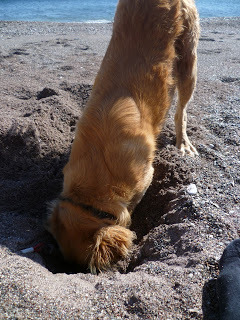

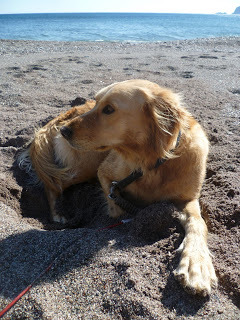
Published on April 13, 2016 10:36
March 24, 2016
It’s (not) Easter!
 Thanks to Eleftheria for this photo of Lisa trying to pull me into the sea at Ayios Antonis!While many places celebrate Easter this weekend, Greek Orthodox Easter falls late this year, as April turns to May, so in Tilos we’re just quietly enjoying the sunshine, walking in a landscape green from winter rains, and swimming in a still-bracing sea…
Thanks to Eleftheria for this photo of Lisa trying to pull me into the sea at Ayios Antonis!While many places celebrate Easter this weekend, Greek Orthodox Easter falls late this year, as April turns to May, so in Tilos we’re just quietly enjoying the sunshine, walking in a landscape green from winter rains, and swimming in a still-bracing sea… This might be my favourite time of year; I can sit here with the sun warming my arm and the occasional bee buzzing through the open window, while in the evenings, even though there’s no real need for heating, it’s sometimes cool enough to light a fire in the hearth. Even though I wouldn't call myself a flower fanatic, it's impossible not to be wowed by the fields bursting with colour, and the tiny orchids. And I’m seeing hoopoes! Hoopoes seem shy and I’ve never been able to get a photo, but they have ginger mohicans and black-and-white striped tails.
If you want to experience a different kind of Easter, you still have time to book a flight to Greece for the ‘Big Week’. You won’t find much in the way of chocolate eggs but it’s very beautiful and brings the community together, from its mournful processions with a flower-covered bier to the firecracker-popping end with lamb or kid roasted on the spit and the burning of Judas. Easter Sunday will coincide this year with Protomayia, the First of May, a national holiday when everyone gathers flowers and hangs wreaths on their front doors, marking the start of summer.
There are plenty of reasons to be thinking of Greece in the coming month leading up to Greek Easter – here are a few….
- * My Big Fat Greek Wedding 2 – the movie is launched this week (!)- * The Durrells, a six-part series based on Gerald Durrell’s books about his childhood on the Greek island of Corfu, is starting on 3 April (https://www.durrell.org/wildlife/the-durrells/)- * Five chefs from Athens are taking over The Real Greek in London’s Bankside on 19 April, hosted by Tonia Buxton, presenter of My Greek Kitchen.- * Athens has been voted #2 Best European Destination for 2016- * My Map of You by Isabelle Broom, set on the island of Zakynthos, is out on 21 April- * An Octopus in my Ouzo, by… oh yes, by me… is out 14 April!!!!!
To rest up a little before the big launch, ahem, I’m looking forward to few little holidays. What? Yes, I know I live on a Greek island. In fact, this is what I just saw when I took the dog for a mid-morning stroll around the village….
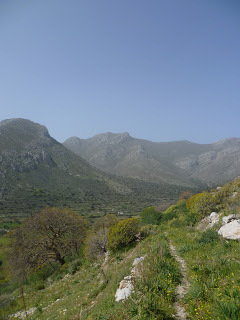
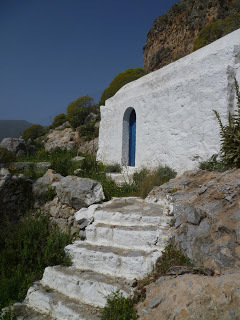
But sometimes it’s fun to see other Greek islands too, especially ones not very far away. First up, Y and I are off to Rhodes this time next week, for errands (because it’s our nearest ‘city’) and then for pleasure. We’ll be staying for a couple of nights at the lovely NikosTakis Hotel – described in my new book – in the heart of the Old Town near the Palace of the Grand Masters; then assuming Y’s car passes its MOT we’ll be doing a fast tour of the island… And the following weekend I’ll be with my mum in Lindos, staying at this traditional Captain’s House run by Exclusively Lindos, which promises to be a treat.
If you haven’t seen the Alpha TV show 60 Lepta Ellada when they came to Tilos in February, you can now see it online here (Lisa and I get our three minutes of fame around minute 16, though several people brought me down to earth by saying that Lisa was the real star). I had some lovely messages from viewers in other parts of Greece and made some new friends. ‘You have touched the meaning of life!’ wrote Yiannis. Stavros wrote to say he’d been to Tilos 20 years ago and the show brought back wonderful memories. Tassos said he was jealous of my life, and thanked me for helping people to learn about his country. Costas wants to learn the key for escaping from a life dominated only by work. And Ilias said he liked to see people enjoying nature and doing what they want in life, not what others want. I now want to watch all the episodes about other parts of Greece, though it will make me want to travel more….
In the meantime, it’s Lent here, so it’s almost obligatory to eat halva, the delicious sweet. Last week, to get into the spirit of things, I cooked fasolada, a thick soup of white beans with carrots, celery, tomatoes and olive oil. Yesterday, around this hour, I heard the shout of ‘Psaria!’, or ‘fish’, and walked down to the road to buy fresh gopes from Nikos’ truck. We grilled them last night and I picked a lemon off my tree to squeeze over. I boiled local potatoes and we sprinkled them with salt and oregano and drizzled them in local olive oil. With a mound of salad and a glass of ouzo... It’s not bad, life on a Greek island.
With apologies to those of you who might already have seen some of these photos on my Facebook page, I'll leave you with some snaps from my walk up to the old Italian Observatory last week. Enjoy yourselves, wherever you are and whatever you're doing... X

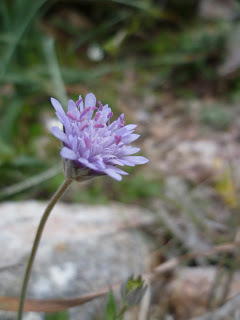


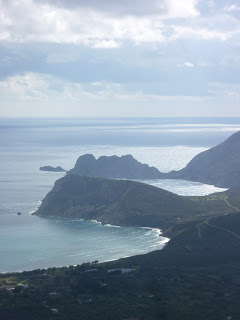

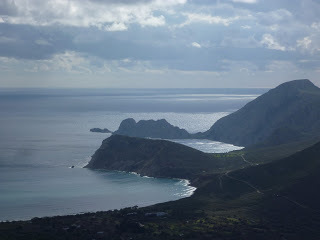
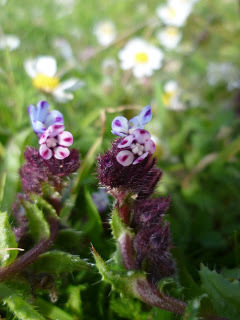
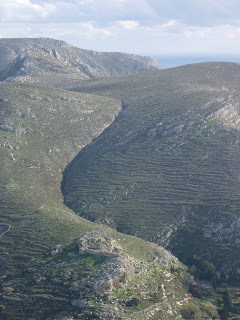
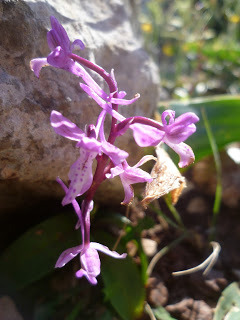

Published on March 24, 2016 02:45
March 12, 2016
Apokries

The year I lived in Athens after I finished university, I had my first glimpse of the Greek version of carnival or Apokries in the Plaka district; I remember Athenians in bright costumes, happily spraying one another with streamers. Then, with a few days off from teaching, I took buses north to Kalambaka to see the Meteora, those strange stubby rocks that rise so sheer from the flat plains that monks of old saw fit to build monasteries on top. On Kathari Deftera, Clean Monday, people picnicked outdoors although the snow was only just melting, and there was a whiff of ouzo on sunny café terraces, while at night the town smelled of woodsmoke from the roaring fires that made bars cosy and warm.
I’ve written before here about the Apokries, the three weeks (or Triodion) before Lent. This year it began on 21 February, and lasts until Sunday 13 March. Traditionally it’s a time for revelry and celebration; this weekend there will be parties where people wear funny or spooky fancy dress.
Here on Tilos, it began with the Gaitanaki, a dance around a pole with intertwined ribbons like a maypole. The event – which has only been brought back into practice in recent years – was scheduled to happen on the Sunday but delayed, perhaps because the strong winds made it impossible; it happened instead in a rather impromptu way a few days later, when the crew from Alpha TV were here getting documentary footage for their 60 Lepta Elladaprogramme (perhaps to be aired later this month). So the performances by the Tilos dance troupe and the schoolchildren were filmed by the drone flying overhead. It was a small but happy crowd gathered in the square, drinking red wine from Petrino and eating pork souvlaki sticks from the barbecue. For me, having missed Greek dance classes for a while, the best part was joining in a few dances again. Though once the firecrackers started going off, Lisa was shaking with fear so we retreated to Megalo Horio...




In the middle of the Apokries period is Tsiknopemti, a Thursday named for the smell of smoke from the grill; friends gather to enjoy meat before they have to give it up. The following week they can still eat cheese but over the course of the three weeks, people gradually abstain from animal foods. On Clean Monday, anything with blood or dairy is forbidden, so people feast on seafood such as octopus and taramasalata, which go so well with ouzo (ah, Yiannis just offered to cook mussels for us!). And then, finally, people are ready for a more austere diet of beans and pulses during Lent. Of course, not everyone observes the religious customs but many do.
While the religious festivals and the big, contemporary carnival parades that take place in certain cities have an appeal of their own – and in ancient times the worshippers of Dionysus would apparently run around waving giant phalluses to encourage the earth to be reborn after the winter, which must have been quite funny - I am fascinated by the pagan roots of these springtime rites. It’s all to do with driving out the bad spirits to make way for the good. It’s also to ensure health and fertility and the fruitfulness of the land.
A century or so ago, the masquerades were darker and more raw and mysterious, with animal masks and fur hoods. And even today in some parts of the north of Greece it's still the same, in Kavala and Drama, where the masquerades happen during the twelve days between Christmas Eve and Epiphany, just before the winter equinox when the days are shortest. I first learned about these traditions at the Museum of Greek Folk Art and you can see a couple of costumes on their website (http://www.melt.gr/en/collection/the-collection/masquerades/, while I also found some wonderful photographs online by Georgios Tatakis: https://www.facebook.com/georgios.tatakis/media_set?set=a.10207923113453859.1073741978.1177445320&type=3https://www.facebook.com/georgios.tatakis/media_set?set=a.10207942596900933.1073741979.1177445320&type=3https://www.facebook.com/georgios.tatakis/media_set?set=a.10207916900858548.1073741977.1177445320&type=3
At Sohos, north of Thessaloniki, at Apokries people walk through the streets wearing long, twisted goat horns, bells and wigs, blowing horns. In Drama, they dress as ‘Arapides’ in fur and feathers, as I found in photos by Lefteris Zopidis:https://www.flickr.com/photos/10048955@N06/3331921207/in/photostream/https://www.flickr.com/photos/10048955@N06/3341217290The ‘Karnavali’ character dresses in goatskins, a tall hat covered in streamers and a mask with a horse-hair moustache. In the final week of Apokries people roam the streets offering ouzo, dancing and jangling bells. Making a noise is important – to frighten off bad spirits, it seems, and awaken the sleeping earth.
The closest thing to mummeries on the islands seems to be on Skyros, technically one of the Sporades but far from Skiathos and Skopelos, nearer to Evia. It draws huge crowds from Athens for the celebrations; locals dress as ‘Yeri’ or old men, their faces blackened or hidden with goatskin or cloth, fur costumes, belts hung with huge bells which clang as they troop around the streets. There’s drinking and traditional dancing, of course.http://www.travelsingreece.com/trips/carnival-in-skyros/
While researching all this online I learned of the festival of ‘Boules’ that takes place at Apokries in Naoussa, the well-known wine-producing region of Macedonia. Men dressing as women and women as men is a common element of the carnival, but it has a special twist here during the masked dance of the ‘Yanitzari’ or Janissary and the ‘Boules’, the Bride. Masks are made of cloth and beeswax with a horsehair moustache, and covered with a trailing turban; costumes are covered in jangling coins.
The Janissaries were soldiers of the Ottoman sultans. Greek boys were taken by force from their families when young and brought up as Muslims. Although the village of Naoussa was for a long while exempt from sending its sons to be Janissaries, in 1705 the Ottomans came to recruit from there too. The locals rebelled and killed those who had come to take away their children. It led to harsh and violent reprisals on the community by the Ottomans.
From then on, the masked dance had a special purpose among the people of Naoussa. It enabled them to hold secret meetings to plot their uprising against Turkish rule, since rebels could slip down from the mountains secretly in disguise. The event, dressed up as a wedding ritual, allowed people to slip money, food and messages to the rebels, and for others to join them. Naoussa rose up against the Turks in 1822 – and was totally destroyed in further reprisals. A sad tale, but one of courage too and the determination of the Greek people to seek their freedom.
Here on Tilos, it feels as though the dark days of winter are over – in fact, this year, we’ve barely had any. The sky and the sea are often blue - which is lovely, although locals have said if it doesn't rain more, animals might die, and we'll have a problem with our own water supply. The fields are full of flowers and awash with colours, red and purple, yellow and white; my favourites are the poppies that glow in the sunshine, and the white and pink spikes of cyclamen, though there are delightful splashes of mauve and pink everywhere you walk.




Last week there was another celebration in the Dodecanese – the day of liberation when this group of islands finally shook off the days (the centuries!) of occupation and repression. After the Ottoman Turks, the Italians, and the Germans - then three years of transition under British rule after World War Two - the Dodecanese became united with Greece on 7 March 1948.

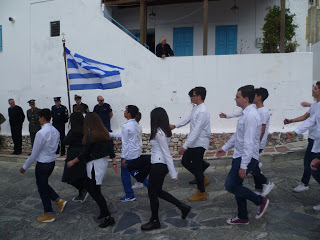

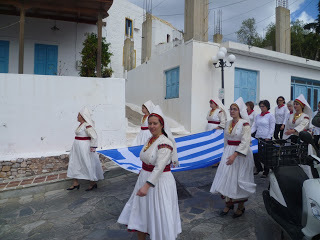

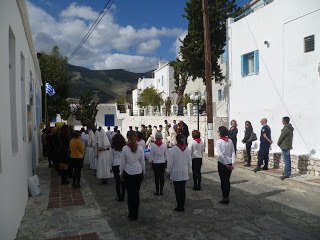
I'd like to sign off here saying 'I'm off to put on my goat horns and bells, blacken my face and join the party!' But it's all quiet here on our little sokaki of Megalo Horio...
Thanks to an article by Mela Kubara and to the ‘Dance Archive’ which I used as sources for some of this research, as well as the Museum of Greek Folk Art.
Published on March 12, 2016 12:06
February 28, 2016
A Long Walk to the Castle, and an Entertaining Evening at Kali Kardia
 There were bees buzzing and, in the blue sky and warm sun, a feel of summer around the corner as we set off on the half-hour walk up the path to Skafi. We reached the sand and I had a sudden longing to lie down and fall asleep.
There were bees buzzing and, in the blue sky and warm sun, a feel of summer around the corner as we set off on the half-hour walk up the path to Skafi. We reached the sand and I had a sudden longing to lie down and fall asleep.Work has been excitingly busy at my home office, feeling strangely like a real office, especially when I got invited out for lunch by an editor in New York, and had to explain that it might be tricky. Not that it’s been all work this week, far from it – with a Greek television crew on the island interviewing us on Tuesday, and the Gaitanaki celebrations on Wednesday… But it’s been a full week. I’d finally found the time to clean the house from top to bottom in the morning: filling up a bag with dust and dog-hair. By 1pm, I felt it was time to give myself a long afternoon off. Lisa, funny creature of habit, tried to pull us back home because it wasn’t time to do our walk of the day yet, but I was having none of it.
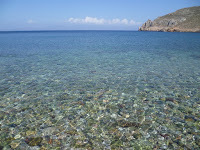
All ideas of dozing on the sand were pushed aside by the sight of the crystal-clear sea glinting invitingly over the colourful pebbles. It had to be done. I braced myself for the cold water, tried not to think about that first minute as I dove under to see the magical blue, then swam quickly until the sea felt good – the best moment – across the bay and back. As usual I started to feel the chill again on the way back, making me speed up my strokes and it was good to get out, although a breeze was moving little clouds across and blocking my sun. One of the best things about winter swimming is how invigorating it is, though: I was now full of energy and although I’d brought a book to read, I felt like a walk. I’d actually brought water and fruit, and a water bowl for Lisa.

We set off up the side of the hill to the north – gentle and dune-like at first, soon getting steeper and rockier – towards the lone tree that you see from the far end of the beach. For years I’ve looked up there as I swim, and now I was looking down, hearing the waves below on the beach, the old fields of the valley clear from this perspective. Now that I was up here, I wanted to cross the ridge to see the view from the other side. It wasn’t far as the promontory seemed to trail off into a very fine sharp point, and it looked unlike any part of Tilos I’d seen. I love the way the island is still full of surprises for me, and the sun made it spectacular. We were now on the side of the promontory that you see from Ayios Antonis. I decided we’d walk the ridge home.
 Lisa gets just as thrilled as I do by exploring a new walk, and she leaped over the thorniest thorn bushes with grace. I feel like John Noakes talking to Shep the dog on days like this (showing my age). In some places, we were able to walk along the old stone terraces; other times we pulled ourselves up and down rocks. Everywhere there were flowers – daisies, the purple blooms on the sage bushes, and endless tiny blue and yellow and purple and white-and-pink flowers. Lisa pulled towards a cliff where we had the caught the most amazing moment of silver rippling sea with clouds above Profitis Ilias. There was a threshing circle on a flattish col, then a tough scramble up a steep slope to the rocky summit again. For the first time, I got up close to a stone-built structure that from afar had looked like an empty windmill; up close, it wasn’t circular at all but a semi-circular tower with tiny windows on the sea in all directions, and steps up to the top.
Lisa gets just as thrilled as I do by exploring a new walk, and she leaped over the thorniest thorn bushes with grace. I feel like John Noakes talking to Shep the dog on days like this (showing my age). In some places, we were able to walk along the old stone terraces; other times we pulled ourselves up and down rocks. Everywhere there were flowers – daisies, the purple blooms on the sage bushes, and endless tiny blue and yellow and purple and white-and-pink flowers. Lisa pulled towards a cliff where we had the caught the most amazing moment of silver rippling sea with clouds above Profitis Ilias. There was a threshing circle on a flattish col, then a tough scramble up a steep slope to the rocky summit again. For the first time, I got up close to a stone-built structure that from afar had looked like an empty windmill; up close, it wasn’t circular at all but a semi-circular tower with tiny windows on the sea in all directions, and steps up to the top.





 It’s exactly this kind of walk, I realised, that gives me a real break – when I’m focused on finding the path, and on holding safely to Lisa’s lead while we negotiate sharp rocky outcrops, my brain lets go of all thoughts of work or anything else. A challenging walk, with a minor element of risk… After a couple of hours or so of scrambling up and down slopes, both my and Lisa’s legs were like jelly. Tired, I had to focus not to fall – even though we were so close to home, there were plenty of tricky parts ahead. We were a little fractious. Lisa had no patience with my stopping now to take photos of flowers, and I had no patience with her taking detours to scare partridges, or follow a goat-track to some un-navigable rocky outcrop. She started pulling on the lead when we happened upon a new-born baby goat and a bloody trail around it from the absent mother. My legs were covered in scratches.
It’s exactly this kind of walk, I realised, that gives me a real break – when I’m focused on finding the path, and on holding safely to Lisa’s lead while we negotiate sharp rocky outcrops, my brain lets go of all thoughts of work or anything else. A challenging walk, with a minor element of risk… After a couple of hours or so of scrambling up and down slopes, both my and Lisa’s legs were like jelly. Tired, I had to focus not to fall – even though we were so close to home, there were plenty of tricky parts ahead. We were a little fractious. Lisa had no patience with my stopping now to take photos of flowers, and I had no patience with her taking detours to scare partridges, or follow a goat-track to some un-navigable rocky outcrop. She started pulling on the lead when we happened upon a new-born baby goat and a bloody trail around it from the absent mother. My legs were covered in scratches.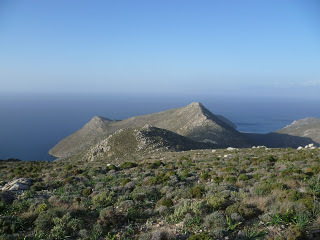
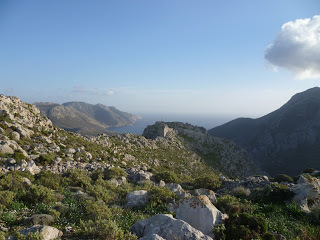 I knew if we made it to the castle, we’d have a clear path down. It was getting closer – again, I was seeing it from a fresh angle. We took one last detour to a chapel which was filled with goat-dung and snail-shells, then down the hill until we were under the steep rock walls; I decided it would be easiest to get within the castle walls and find the path from there, so I helped Lisa leap over an old fence, and feeling very James Bond we helped one another over the castle wall – and were safe. We now were right above Megalo Horio, and just had to be careful not to slip on the loose rocks. We’d been out and about for over five hours. My legs barely worked. A simple dinner of potatoes and cabbage and broccoli with eggs and tinned fish had never tasted so good, washed down with restorative beer.
I knew if we made it to the castle, we’d have a clear path down. It was getting closer – again, I was seeing it from a fresh angle. We took one last detour to a chapel which was filled with goat-dung and snail-shells, then down the hill until we were under the steep rock walls; I decided it would be easiest to get within the castle walls and find the path from there, so I helped Lisa leap over an old fence, and feeling very James Bond we helped one another over the castle wall – and were safe. We now were right above Megalo Horio, and just had to be careful not to slip on the loose rocks. We’d been out and about for over five hours. My legs barely worked. A simple dinner of potatoes and cabbage and broccoli with eggs and tinned fish had never tasted so good, washed down with restorative beer.
 I was planning to write about Apokries – since today ends the first week of this three-week period before Lent, and I’ve been unearthing some interesting stuff about pagan ceremonies to drive out the evil spirits of winter – but I’m running out of space, and with the sun shining in a blue sky and that walk yesterday, any evil spirits feel well and truly subdued. So instead I will tell you quickly about Thursday, when I arrived at Kali Kardia to much enthused shouting and argument.
I was planning to write about Apokries – since today ends the first week of this three-week period before Lent, and I’ve been unearthing some interesting stuff about pagan ceremonies to drive out the evil spirits of winter – but I’m running out of space, and with the sun shining in a blue sky and that walk yesterday, any evil spirits feel well and truly subdued. So instead I will tell you quickly about Thursday, when I arrived at Kali Kardia to much enthused shouting and argument.It seems there was some problem with the reading of the electricity meters, and Lefteris was standing his ground saying it wasn’t his fault, while Nikos the ex-Taxijis turned as red as his jaunty shirt in anger, and Grigoris of the many orange trees stated his case. Nikitas sat quietly slouching in his tweedy jacket and thin scarf, peering over his glasses to roll his cigarette. ‘Why are you shouting?’ he asked Grigori. ‘Are you scared?’ roared Grigoris back. ‘No, why are you shouting?’ persisted Nikitas calmly. ‘Because I want to shout!’ laughed Grigoris. When Gunter left, Nikitas hurried after him, worried he’d been driven off by the argument. ‘Ohi, efige omorfa,’ said someone, he left in a nice way.
Of course everything calmed down very soon and gradually people started to say goodnight and went their way home, and by then we were all in good moods and laughing, so when old Pantelis the goat farmer arrived and seemed in a dour frame of mind, Lula told him she liked his new waterproof jacket.
Pantelis speaks several languages from having worked on the ships years ago, but has a slight speech impediment which makes whatever he’s saying come out in a nasal, gruff way. Perhaps to make up for this, he has a way of elaborating on what he’s saying with large gestures, throwing his arms out and spreading his cartoonishly huge fingers wide.
‘This?’ he said. ‘I’ve had this jacket for a decade.’ He got up from his seat and quietly stood centre stage in the middle of the room, and seemed to be taking it off – but without removing his hands from the sleeves, so gradually as he shrugged his jacket off and it fell towards the floor, it turned inside out. Then he pulled out his hands and with a typically dramatic flourish, like a magician he produced – a new fleece jacket!
He slowly put this completely new-seeming jacket back on, having demonstrated its ingenious reversibility which had fooled Lula into thinking he had a new jacket, everyone laughed and cheered, and Pantelis was taking a bow and about to sit down when Nikos shouted out, ‘What about the trousers?!’ Pantelis didn’t skip a beat and his fingers flew immediately to the top button of his flies, making Lula and the rest of us shriek with laughter. Then he stopped and turned around and said, ‘Sorry, my frien’ – joking, joking…’

Published on February 28, 2016 00:32
February 20, 2016
Raki and Fish
[image error]
Raki and fish... Sounds almost as good as octopus and ouzo, doesn't it?
'All my life, in whatever city I visit, I've always found myself in search of fish markets,' writes Tan Morgul in the Beirut chapter of this luscious book. Tan, a journalist from Istanbul, is the writer and Stratis Vogiatzis, from the Greek island of Chios in the Aegean, is the photographer. Together, over several months in the winter of 2013, they travelled to 11 cities around the Mediterranean sampling variations on the simple and exquisite combination of raki and fish, and they put together this book that is a feast for the eyes. It resonates with 'the sound of the waves and the smell of the sea'.
It's not just a cookbook, and not just a travel book, but an opinionated and lively exploration of the Mediterranean passion for seafood, capturing a snapshot of the geography, the mythology, the poetry, the stories of each place. It opens in Istanbul, where 'fish is caught not with net or rod, but with raki' according to Ara Guler - and last night I travelled with them through Beirut and Alexandria...
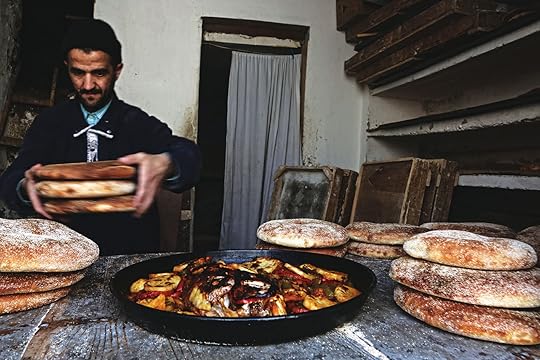
We learn the Turkish saying: 'If my own father came out of the sea, I'd eat him!' We learn about the fish themselves along the way, from monkish to sardines, as well as how they are eaten locally. We learn about serving roasted grouper with tahini sauce, and about marinating bonito (small tuna, called palamitha here on Tilos) in garlic, olive oil, onion, lemon juice and soy sauce.
We learn about salads with slices of cured fish roe, dressed in thyme, onion, lemon, salt and olive oil - all things we can source locally here - and I'd love to try making a dish with dandelion greens sauteed with calamari in lemon and olive oil - perfect for winter on Tilos when all those things are fresh and in season. We learn about fish felafel, tabbouleh with tuna, hummus with fish confit - Beirut is big on pairing fish with grains and legumes.
I was also fascinated to read that the word raki has its origins in the word 'araq', which means 'sweat' - the drops that collect as it emerges from the still. Arabs originated the tradition of distilling drinks in Lebanon.

The photographs are not only of food but of kitchens, of fishing boats under stormy skies in inky waves, of steam and ripe tomatoes and spices, of the wet paving stones of old markets, of expressions captured on faces.
Tan laments the damage inflicted on our seas by pollution, and the damage inflicted on the Mediterranean shores by bland development. Some of the places were experiencing economic crisis, political and social upheaval, even revolution, but as Tan writes, 'in these tense times... we went in search of a warm conversation'. This book is a wonderful celebration of Mediterranean culture and I can't wait to continue the journey through Tunis, Tangier, Lisbon, Barcelona, Marseille, Genoa, Dubrovnik, Athens.
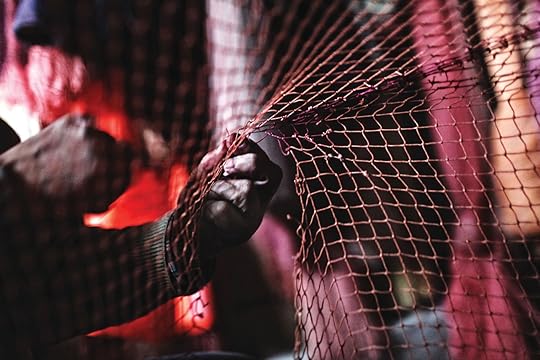
The book can be ordered from Amazon.com but if you have problems please feel free to get in touch. You can find a small selection of Stratis' beautiful photographs along with an introduction to the book by Tan here:
http://www.stratisvogiatzis.com/projects/mediterranean-sea-food-odyssey
Thanks to the guys for sending me a copy.
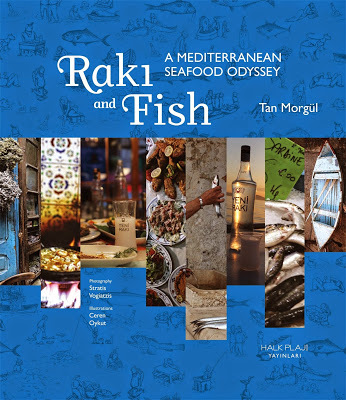
Raki and fish... Sounds almost as good as octopus and ouzo, doesn't it?
'All my life, in whatever city I visit, I've always found myself in search of fish markets,' writes Tan Morgul in the Beirut chapter of this luscious book. Tan, a journalist from Istanbul, is the writer and Stratis Vogiatzis, from the Greek island of Chios in the Aegean, is the photographer. Together, over several months in the winter of 2013, they travelled to 11 cities around the Mediterranean sampling variations on the simple and exquisite combination of raki and fish, and they put together this book that is a feast for the eyes. It resonates with 'the sound of the waves and the smell of the sea'.
It's not just a cookbook, and not just a travel book, but an opinionated and lively exploration of the Mediterranean passion for seafood, capturing a snapshot of the geography, the mythology, the poetry, the stories of each place. It opens in Istanbul, where 'fish is caught not with net or rod, but with raki' according to Ara Guler - and last night I travelled with them through Beirut and Alexandria...

We learn the Turkish saying: 'If my own father came out of the sea, I'd eat him!' We learn about the fish themselves along the way, from monkish to sardines, as well as how they are eaten locally. We learn about serving roasted grouper with tahini sauce, and about marinating bonito (small tuna, called palamitha here on Tilos) in garlic, olive oil, onion, lemon juice and soy sauce.
We learn about salads with slices of cured fish roe, dressed in thyme, onion, lemon, salt and olive oil - all things we can source locally here - and I'd love to try making a dish with dandelion greens sauteed with calamari in lemon and olive oil - perfect for winter on Tilos when all those things are fresh and in season. We learn about fish felafel, tabbouleh with tuna, hummus with fish confit - Beirut is big on pairing fish with grains and legumes.
I was also fascinated to read that the word raki has its origins in the word 'araq', which means 'sweat' - the drops that collect as it emerges from the still. Arabs originated the tradition of distilling drinks in Lebanon.

The photographs are not only of food but of kitchens, of fishing boats under stormy skies in inky waves, of steam and ripe tomatoes and spices, of the wet paving stones of old markets, of expressions captured on faces.
Tan laments the damage inflicted on our seas by pollution, and the damage inflicted on the Mediterranean shores by bland development. Some of the places were experiencing economic crisis, political and social upheaval, even revolution, but as Tan writes, 'in these tense times... we went in search of a warm conversation'. This book is a wonderful celebration of Mediterranean culture and I can't wait to continue the journey through Tunis, Tangier, Lisbon, Barcelona, Marseille, Genoa, Dubrovnik, Athens.

The book can be ordered from Amazon.com but if you have problems please feel free to get in touch. You can find a small selection of Stratis' beautiful photographs along with an introduction to the book by Tan here:
http://www.stratisvogiatzis.com/projects/mediterranean-sea-food-odyssey
Thanks to the guys for sending me a copy.

Published on February 20, 2016 22:45
February 13, 2016
Sharing the love
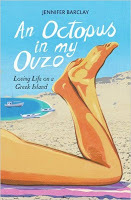
In April, when this book is launched, it will be five years since I came to live on the tiny Greek island of Tilos, a place I'd fallen in love with. I came here for a different kind of life: to spend more time outdoors and in the sea, to learn about the ways of a traditional Greek island and see if I could work from home and live the dream. AN OCTOPUS IN MY OUZO is a celebration of life in Greece.
A few weeks ago, I nervously sent messages to some authors, asking if they might read the proofs. This is a lovely tradition in books, where other authors can offer words of endorsement. I've been lucky in the past so I crossed my fingers that a few would agree to read it, and one or two might like it. Well, lo and behold...
If you love Greece, then you're probably familiar with The Mysteries of the Greek Detective series by Anne Zouroudi - brilliant stories, beautifully written and full of fascinating, authentic details of Greek island life (don't just take my word for it - Alexander McCall Smith is a fan). So how thrilled was I when Anne wrote the following endorsement?
'Poetic, touching, enlightening: Jennifer's very personal journey into Greece's deep heartland will give even the most couch-bound armchair traveller itchy feet.'
Edward Enfield wrote another book Grecophiles might know, Greece on my Wheels. When I worked at Summersdale, I became friends with him, working with him on subsequent books, and we still exchange letters. Through him I connected with his daughter, Lizzie Enfield , whose novels about relationships make absorbing, thought-provoking and entertaining reading and who also writes about Greece for newspapers. The next wonderful endorsement came from Lizzie:
'A seductive evocation of Greek island life and an honest exploration of what it means to try to live differently. An Octopus in my Ouzo is about diving into the unknown and staying afloat, even when the enticing blue waters of the Aegean become choppy.'
You may know Emma Woolf from TV or radio; she and I first met in Stanfords travel bookshop and since then we've been firm friends. She wrote great things about Falling in Honey and I was hopeful that she would read this one as her own new book, Positively Primal, is about finding health and happiness in a hectic world - which is something I was aiming for when I moved to Tilos. She's a great advocate of women's health and happiness and has also published a novel called Ways of Escape, a love story set against a backdrop of travel. Anyway... she said yes! She wrote:
'Romantic, sun-drenched and mouth-watering: a true feast for the senses.'
AN OCTOPUS IN MY OUZO, which heads to the printer this coming week, couldn't be off to a better start. It's available for pre-order on Amazon here, by the way. Thanks to these fabulous ladies for sharing the love!
Published on February 13, 2016 23:11
February 6, 2016
A Walk to Livadia
I'm just going to think about Tuesday.
Yesterday, Friday, it rained all day. I walked to Ayios Andonis in the afternoon and got soaked to the skin. Lisa and I don't mind a bit of rain, but even she baulked at the big, driving hailstones and we had to take shelter. Today it's sunny but there's a sharp, strong wind blowing that almost brought me to a standstill on the way back from Eristos. We're settled in front of the heater for the night. But Tuesday... Tuesday was beautiful. And since I had to visit the ATM anyway, I took the afternoon off and walked in shorts and t-shirt to Livadia. I saw almond blossoms, wild cyclamen, an eagle... And of course, I went for a swim.
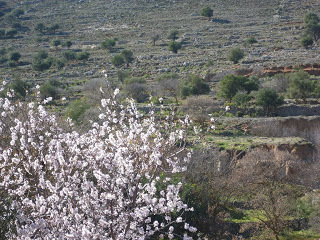


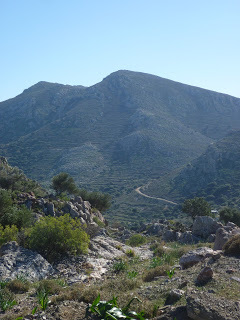




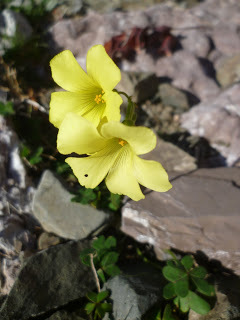


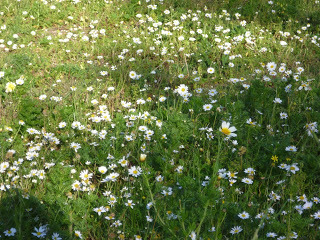 Sofia decided to give up running the kafeneion in Megalo Horio this winter, and it's been taken over by the Hatzifountas brothers from En Plo, who have changed things a little and put in a wood-burner for winter. They're also offering food now. I've been there twice with friends this week, feeling very lucky that we have another great place to go out for a drink and meze in the evening - a little plate of octopus with your ouzo, if you like.
Sofia decided to give up running the kafeneion in Megalo Horio this winter, and it's been taken over by the Hatzifountas brothers from En Plo, who have changed things a little and put in a wood-burner for winter. They're also offering food now. I've been there twice with friends this week, feeling very lucky that we have another great place to go out for a drink and meze in the evening - a little plate of octopus with your ouzo, if you like.
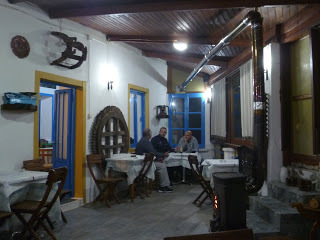
 Finally, some photos of Ayios Andonis in a mixture of clouds and sunshine early this week, with the fishermen pulling in nets.
Finally, some photos of Ayios Andonis in a mixture of clouds and sunshine early this week, with the fishermen pulling in nets.




Yesterday, Friday, it rained all day. I walked to Ayios Andonis in the afternoon and got soaked to the skin. Lisa and I don't mind a bit of rain, but even she baulked at the big, driving hailstones and we had to take shelter. Today it's sunny but there's a sharp, strong wind blowing that almost brought me to a standstill on the way back from Eristos. We're settled in front of the heater for the night. But Tuesday... Tuesday was beautiful. And since I had to visit the ATM anyway, I took the afternoon off and walked in shorts and t-shirt to Livadia. I saw almond blossoms, wild cyclamen, an eagle... And of course, I went for a swim.












 Sofia decided to give up running the kafeneion in Megalo Horio this winter, and it's been taken over by the Hatzifountas brothers from En Plo, who have changed things a little and put in a wood-burner for winter. They're also offering food now. I've been there twice with friends this week, feeling very lucky that we have another great place to go out for a drink and meze in the evening - a little plate of octopus with your ouzo, if you like.
Sofia decided to give up running the kafeneion in Megalo Horio this winter, and it's been taken over by the Hatzifountas brothers from En Plo, who have changed things a little and put in a wood-burner for winter. They're also offering food now. I've been there twice with friends this week, feeling very lucky that we have another great place to go out for a drink and meze in the evening - a little plate of octopus with your ouzo, if you like.

 Finally, some photos of Ayios Andonis in a mixture of clouds and sunshine early this week, with the fishermen pulling in nets.
Finally, some photos of Ayios Andonis in a mixture of clouds and sunshine early this week, with the fishermen pulling in nets.




Published on February 06, 2016 07:22
January 30, 2016
A Bikini in my Backpack
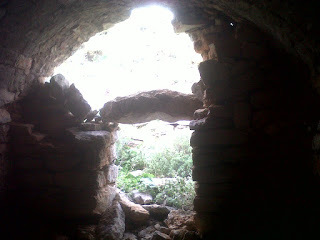 Two days ago, I finished my work and headed out for a walk, rather optimistically with a bikini in my backpack, as well as gloves and a scarf. There was a cool wind, but not cold. Down at Eristos, the bay felt sheltered and the sea was blue and clear. Jumping in was hard –no question, it was cold – but after the first few minutes, I relaxed and enjoyed it. Coming out, I piled the clothes back on and had such a burst of energy that I ran half the way home. I’d left bread dough to rise, and I could barely wait for it to finish baking before I was tearing chunks off and eating…
Two days ago, I finished my work and headed out for a walk, rather optimistically with a bikini in my backpack, as well as gloves and a scarf. There was a cool wind, but not cold. Down at Eristos, the bay felt sheltered and the sea was blue and clear. Jumping in was hard –no question, it was cold – but after the first few minutes, I relaxed and enjoyed it. Coming out, I piled the clothes back on and had such a burst of energy that I ran half the way home. I’d left bread dough to rise, and I could barely wait for it to finish baking before I was tearing chunks off and eating…Yesterday was overcast, and after my morning’s work I felt a little tired when I took Lisa for her lunchtime walk; not sure which direction to take, I ended up trying a track off the road towards Ayios Antonis, heading uphill on the easterly, inland side of Profitis Ilias. The track turned into a path that was soon barely perceptible and we were cutting through spiky bushes. Just the kind of thing Lisa loves – at the end of the lead she panted and surged forward on the scent of goats, leaping over thorny bushes and pulling me through stands of dead trees. At one point I thought, I’m not really enjoying this, but going back would have been just as hard as going forward, and ahead I hoped we’d be able to cross the gorge and take a track down. I was wondering how far we should go when I spotted some ruined buildings and an old chapel, so I decided to aim for that. The walk from there on led steeply up the mountain and could have been fun if I’d had more daylight and energy.
The chapel turned out to be typical of the many abandoned chapels all over the hillsides. Crouching to enter under the heavy rock lintel – the doorway was now half-sunk under rubble – I tiptoed over a carpet of goat-dung strewn with the remains of a long-dead goat to see the fallen, simple altar made from a column and a slab of marble, most likely ancient. There was a fragment of another marble slab nearby with old carving, the corner of something much bigger… The secrets these little places hold. The walls were bare stones – but no, when I looked more closely into an arched recess, I could make out very faintly the colours of Byzantine-style frescoes, including the top of a saint’s head, with a tiny forelock of hair.


I emerged into the still-grey scene outside, and saw a few spots of sunlight lighting the hills. On the way down I found another chapel, this one built into the rock; the inside had been plastered over at some point, and there was graffiti from the early 1950s. Amid some green terraces dotted with purple anemone flowers there was an old plastic tank and Lisa refused to go near it. The intrepid hound who’d been eagerly pulling me up the hillside was now afraid of an unidentified foreign object in the landscape.
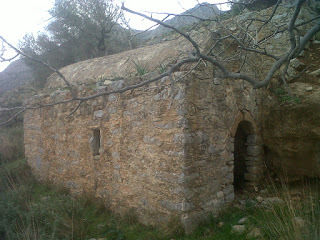 When we made it back down to the shore at Ayios Andonis, we had a surprise. First, the sun was winning over the clouds.
When we made it back down to the shore at Ayios Andonis, we had a surprise. First, the sun was winning over the clouds.
 Then, at the harbour, I saw what I thought at first was someone swimming, just a head above water – but no, it was a seal. It flipped, its tail came out of the sea and it dived down; then emerged, flipped and dived down again a few times as it headed out to sea. Lisa was as spellbound as I was. Well, except when she heard a goat behind us...
Then, at the harbour, I saw what I thought at first was someone swimming, just a head above water – but no, it was a seal. It flipped, its tail came out of the sea and it dived down; then emerged, flipped and dived down again a few times as it headed out to sea. Lisa was as spellbound as I was. Well, except when she heard a goat behind us...


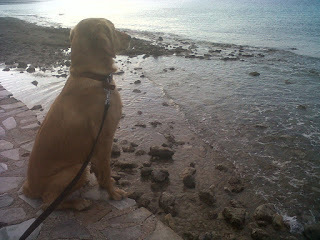
In the evening, I went to Kali Kardia with Ed and Maddie. Michalis H was there, wearing his warm fishing hat although there was a good heat coming off the wood-burner. Yorgos from Filoxenia came by, carrying two large oranges, and mysteriously put them on a table and left. As we were eating and drinking, Michalis came over with a few dark insides of shellfish, dressed in oil and lemon, for us to try. Ed and Maddie didn’t like them much, but to me they were as tasty as oysters. Late in the evening the other Michalis, the owner of the restaurant, came out with a fish on a platter, smacking his lips. He put it down at the table he was sharing with Michalis H, who had clearly caught the fish that day. ‘The restaurant’s now self-service,’ he said, grinning, as they started to eat.
Today, the sun won over the clouds again. Again I headed down to Eristos, happy as it was Saturday and I didn’t have much to do. In fact, I hoped to buy vegetables from one of the farms. But at the first farm, they were working in a distant field, and at the next there was no-one to be seen; and at the third, I learned that Dimitris had the scales and so on down in Livadia, and would be heading off on the boat and wouldn’t be back until Thursday.
By then, I was almost at the beach and happy to walk to my favourite spot for a swim. I made the mistake of lying on the sand for a while – enjoying the thought that I was sort-of sunbathing at the end of January, with the whole of Eristos beach to myself. The trouble is, it made it a lot harder to go in the water. It really was a question of mind over matter. But again, after a tough few minutes of cold, it felt great. And drying off and getting dressed in the mild sunshine felt great too. On the way back via the farms, I found Yorgos and a crew of workers (mostly my Albanian neighbours) dusting dirt off potatoes as they loaded them into crates. Victory! Yorgos filled me a bag of potatoes, then went and cut me two cabbages, a head of broccoli and a head of cauliflower from the sunny field. I proffered money but Yorgos didn’t have any change on him. ‘Pay me another time!’ he said, wiping his knife and heading back to work.
Published on January 30, 2016 10:49
January 23, 2016
Sunny Winter Days and Moonlit Nights
 A cold, north wind howls around the house today, slipping in the gaps around old doors and windows. But it’s been dry, with a deep blue sky, and a brisk walk to feel the warmth of exercise and sun was just what I needed.
A cold, north wind howls around the house today, slipping in the gaps around old doors and windows. But it’s been dry, with a deep blue sky, and a brisk walk to feel the warmth of exercise and sun was just what I needed.

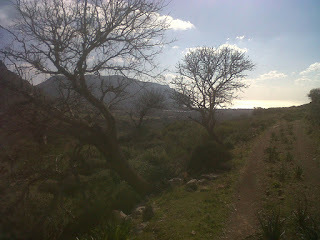
Earlier in the week we had a couple of days of being cooped up by rain (much needed by the farmers). A big storm came in on Sunday and the power went out mid-morning. The sun poked through grey clouds creating a streak of silver across very rough grey and white waters in Eristos bay. I walked Lisa, taking care since the wind had broken branches off the trees, then when the power was still out I crept under the duvet with a cup of tea (the briki and camping stove, usually for Greek coffee, come in handy when there’s no electricity), read a book and then slept for a while. In the afternoon I lit a candle and the fire, preparing for the evening, but the power came back. I rang Angeliki, the artist who lives at the top of the village, to see if we were still on for drinks and we were. She’d prepared a feast of mezes and we sat beside a cosy log fire with the rain pouring down outside.
Our friend Maddie, meanwhile, was flying from Athens to Rhodes. The first flight was cancelled; the second got as far as Rhodes, circled and turned back, unable to land. She made it later that night. Edward had planned to meet her at the airport but his ferry left about twelve hours late. So it can go when you make travel plans in the winter.
The next day the rain continued. Y and I walked to Eristos, skirting deep puddles on the dirt tracks, and found ourselves watching a storm out to sea, wind whipping up the water, waterspouts funnelling down from dark grey clouds, a streak of lightning flashing. It felt like winter was really here. Indulging in a little too much wine and food with friends, walking home in moonlight. Expected parcels are delayed, and delayed - but delayed gratification can be good. Sometimes in the winter, several days can go by when we don’t have vegetables delivered by the boats. The farms at Eristos have potatoes and oranges and broccoli, but other produce was withering badly. Hence my joy at finding plump, fragrant mushrooms at Megalo Horio supermarket one day. Life is full of surprises.
As Lisa and I walked down to Skafi today, the wind made my eyes water. It was fun to stand above the cove and feel the sea crashing powerfully into the rocks. Funny to think I’d had a long swim here on a calm, warm day just two weeks ago, in the first week of January. The wind will drop again soon and we’ll be swimming again, but for today it was good to see wild, surging, white-capped waves.

 When I downloaded photos from my phone, there was another surprise – photos I’d forgotten about. A couple of weeks ago I’d had an impromptu adventure. Climbing up the hill above Harkadio Cave one warm lunchtime to see the medieval chapel and castle ruins, the views had been so breathtaking that on a whim I’d decided to keep walking along the ridge. The sunlight was a dream and the views clear – north to Nisyros and the islands beyond, south to Rhodes and southeast to snow-covered mountains in Turkey. It was a tricky walk, clambering over rocks with Lisa on the lead to stop her chasing goats. I hadn’t taken a camera with me and my phone battery had given up, rather unnervingly – but not before I got a few shots.
When I downloaded photos from my phone, there was another surprise – photos I’d forgotten about. A couple of weeks ago I’d had an impromptu adventure. Climbing up the hill above Harkadio Cave one warm lunchtime to see the medieval chapel and castle ruins, the views had been so breathtaking that on a whim I’d decided to keep walking along the ridge. The sunlight was a dream and the views clear – north to Nisyros and the islands beyond, south to Rhodes and southeast to snow-covered mountains in Turkey. It was a tricky walk, clambering over rocks with Lisa on the lead to stop her chasing goats. I hadn’t taken a camera with me and my phone battery had given up, rather unnervingly – but not before I got a few shots.


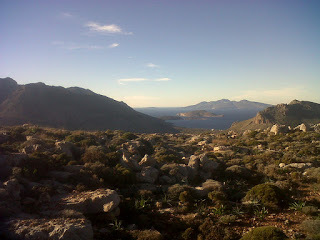
Published on January 23, 2016 07:45
January 3, 2016
Stories from the Kitchen
 At midday on New Year’s Day we went to gather wood for the fire. The sky was blue and the sun warm, but a bitterly cold wind was blowing the sea into whitecaps and it would be chilly when darkness fell. Back at home, we put some pieces of goat meat in the oven with garlic and oregano and oil and potatoes.
At midday on New Year’s Day we went to gather wood for the fire. The sky was blue and the sun warm, but a bitterly cold wind was blowing the sea into whitecaps and it would be chilly when darkness fell. Back at home, we put some pieces of goat meat in the oven with garlic and oregano and oil and potatoes.

The goat had been a gift. My landlord has apartments near the sea at Ayios Antonis, but being primarily a goat farmer he doesn’t use a computer and asked me to help him promote them online, which I did through Airbnb. He wanted to pay me for my time but I said he could give me something like olive oil instead. ‘Theleis katsikaki?’ he asked – do you want a baby goat? He said he’d cut it up into portions for me, and when I went to pick it up, he handed it to me in a plastic bag. ‘I put the head in there too,' he said, 'so you can make soup with it.’ The head is still deep in a corner of my freezer. I’m not that adventurous a cook.
While the meat was cooking, Y and I made marmalade from a couple of kilos of mandarins and clementines. We peeled the fruit and quartered it, throwing the skins of five or so into the pot alongside, then covered it with water and boiled it for half an hour. The water poured off, we removed the pips from every segment as the fruit cooled, taking care not to lose any juice. Then we blended it up and, adding sugar and water, boiled it again, hoping it would thicken enough. It seemed very much like mandarin soup so we left it bubbling away, and moved the dining table in front of the fire while we drank and ate and celebrated the new year.
This time last year, I was reading a lot about food. My publisher Summersdale proposed I put together a collection of food excerpts and references from classic and contemporary literature – novels, poems and plays – along with recipes inspired by them. The book, A Literary Feast , was published in summer 2015. A couple of months later, I received a gift in the post from Everyman’s Pocket Classics, who had published a similar book called Storiesfrom the Kitchen edited by Diana Secker Tesdell. I was intrigued to find out how it compared.

 The two books complement one another well, as while the main ingredients in A Literary Feast are finely sliced pieces with trivia and recipes, Stories from the Kitchen is made with meaty chunks of literature – a longer meal rather than a collection of mezes. It focuses exclusively on novels from the last few hundred years, and shows how writers use food and meals to explore different themes. Everyman’s budget presumably allowed them to pay for longer excerpts from contemporary (in copyright) works, and among those contemporary excerpts were some of my favourite pieces.
The two books complement one another well, as while the main ingredients in A Literary Feast are finely sliced pieces with trivia and recipes, Stories from the Kitchen is made with meaty chunks of literature – a longer meal rather than a collection of mezes. It focuses exclusively on novels from the last few hundred years, and shows how writers use food and meals to explore different themes. Everyman’s budget presumably allowed them to pay for longer excerpts from contemporary (in copyright) works, and among those contemporary excerpts were some of my favourite pieces.In my book I’d quoted a loveable nugget of Nora Ephron on potatoes and love from her autobiographical novel, Heartburn – ‘Nothing like mashed potatoes when you’re feeling blue’. The effect of the longer excerpt in Stories from the Kitchen is surprisingly different; the way she talks about making complicated potatoes for first dates makes her sound like hard work. But the first piece I really loved was ‘A Bunch of Broccoli on the Third Shelf’, which begins with the narrator's husband pulling a forgotten piece of broccoli from the fridge, because Nina, who’s come to America from Russia, is obsessed with shopping for vegetables. I’d never heard of Lara Vapnyar, but her story was a delight and made me want to read more of her work.
Amy Tan’s ‘Best Quality’ was another wonderful and moving story about the narrator’s relationship with her mother, who cooks crabs for Chinese New Year; the character delineations are brilliant and the story twists unpredictably. And I found T.C. Boyle’s piece about a restaurateur and a reviewer, ‘Sorry Fugu’, thoroughly entertaining. Others will undoubtedly have different tastes, but for me it was less the classic pieces from Proust or Zola, Dickens or MFK Fisher, and more the modern pieces that captivated. Some of the very long excerpts made me wonder if I really wanted to read so much of a novel if I wasn’t reading the whole thing, but an exception was the thirty-odd-page dinner party in To The Lighthouse, which worked brilliantly as a stand-alone piece in the Memorable Meals section – not so much about the food but the relationships between those sitting around the table.
If I had to pick a favourite excerpt – well, call me biased but I’d say Gerald Durrell’s very funny ‘Owls and Aristocracy’ from Birds, Beasts and Relatives , set in Corfu, hit all the right notes. He’s invited to dine in winter – when ‘Everything was redolent with the smoke of olive-wood fires’ – at the home of the Countess Mavrodaki for the purposes of collecting a barn owl. His brother, Lawrence Durrell, is very jealous of the invitation. Gerald dresses up for the occasion in a crisp white shirt and new sandals, only to fall off his donkey into a muddy ditch on the way. But it doesn’t matter because the Countess is a surprisingly eccentric character. The feast is gargantuan, starting with a soup and ‘fingernail-sized croutons floating like crisp little rafts on an amber sea’; proceeding through fish and snipe, to the wild boar with ‘piles of the lovely little golden wild mushrooms… tiny marrows stuffed with sour cream and capers’. Every course has so many delicious accompaniments… Durrell surreptitiously undoes the top three buttons of his shorts.

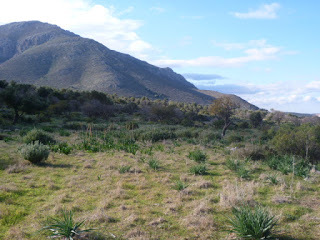
Published on January 03, 2016 07:31



